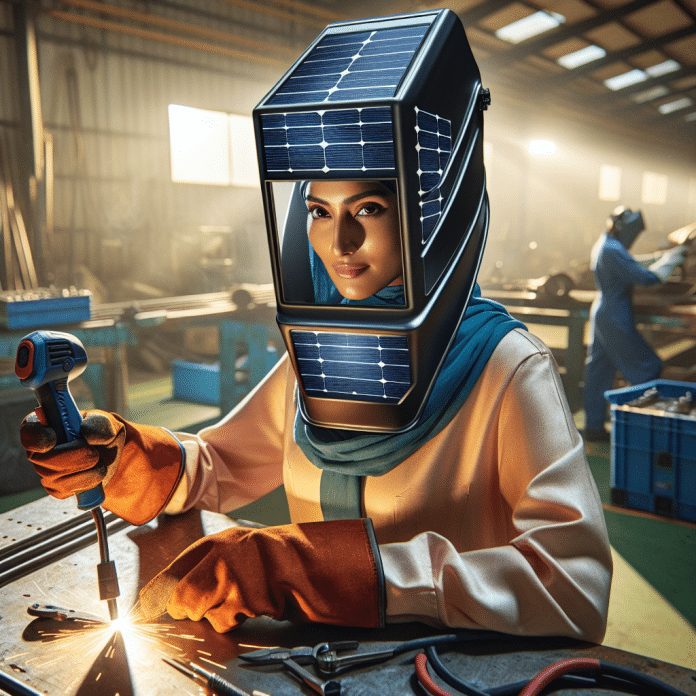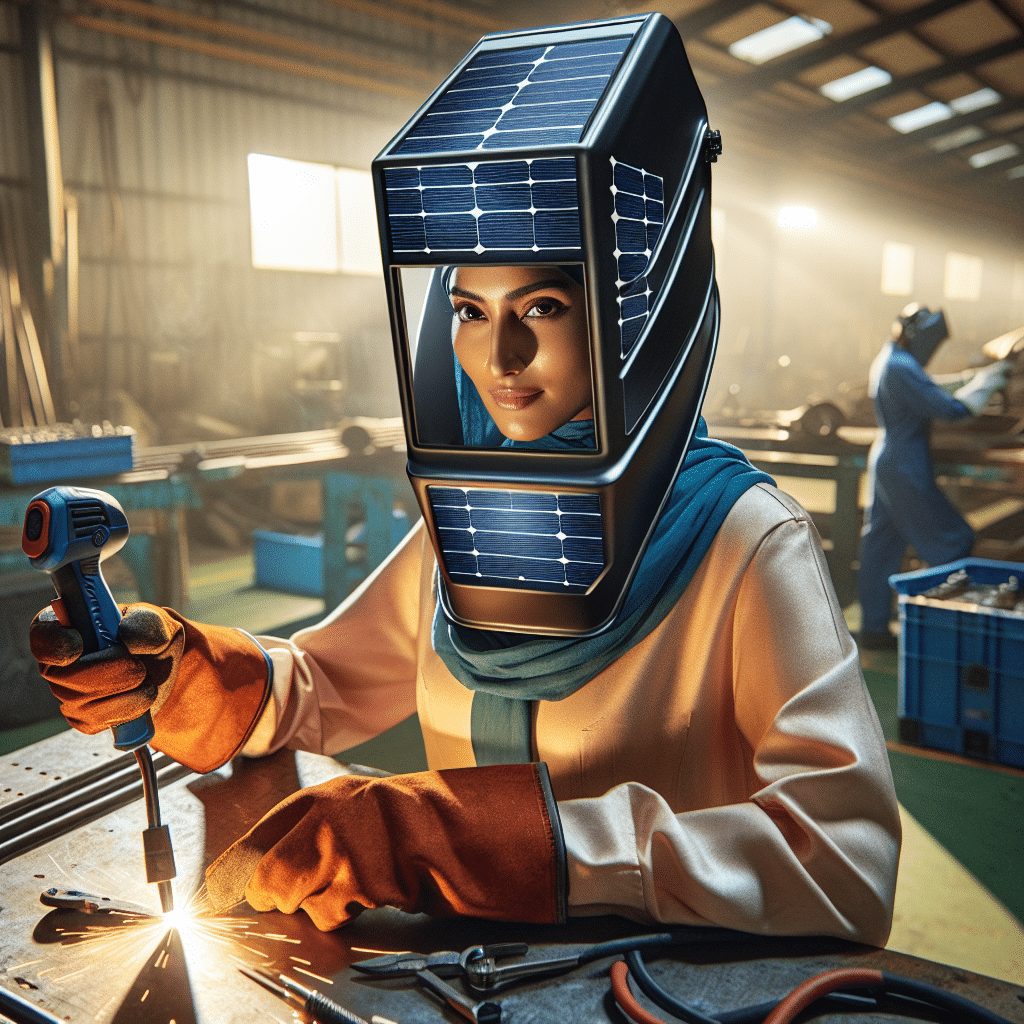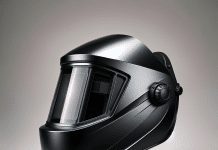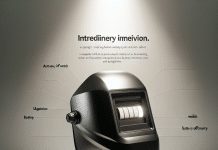Imagine never having to worry about your welding helmet battery dying in the middle of a project again. With the innovation of solar powered welding helmets, this concern is a thing of the past. These helmets harness the power of the sun to keep them charged, ensuring that you can work uninterrupted for hours on end. Say goodbye to the hassle of constantly replacing batteries and hello to a more efficient and convenient welding experience. Discover the benefits and features of solar powered welding helmets that are revolutionizing the industry.
Review contents
Advantages of Solar Powered Welding Helmets
Solar powered welding helmets offer several advantages over traditional battery-powered helmets. First and foremost, they eliminate the need for batteries, which means you never have to worry about running out of power in the middle of a project. This not only saves you time and money but also reduces waste by eliminating the need for disposable batteries.
Another significant advantage is that solar powered welding helmets provide a continuous power source. Unlike battery-powered helmets that may lose power over time, solar powered helmets ensure a reliable power supply throughout your welding session. This means you can work uninterrupted without any power interruptions, allowing for greater efficiency and productivity.
In terms of safety, solar powered welding helmets offer improved protection for welders. The auto-darkening feature, made possible by solar cell technology, ensures that the lens automatically darkens when an arc is struck, protecting your eyes from harmful UV and infrared rays. This immediate response time greatly reduces the risk of eye injuries, providing a safer welding experience for the user.
In addition to their practical advantages, solar powered welding helmets are also environmentally friendly. By harnessing the power of the sun, these helmets reduce the reliance on fossil fuels and minimize carbon emissions associated with traditional power sources. This makes solar powered welding helmets a sustainable choice for welders who want to reduce their carbon footprint.
While the initial cost of a solar powered welding helmet may be slightly higher than a battery-powered one, it proves to be more cost-effective in the long run. With no need for battery replacements, you save money on ongoing maintenance and reduce the overall lifetime cost of the helmet. Additionally, the energy savings achieved by using solar power can result in significant financial savings over time, making it a wise investment for both professional and hobbyist welders.
How Solar Powered Welding Helmets Work
Solar powered welding helmets work by harnessing the power of the sun through photovoltaic panels. These panels, often located on the top of the helmet, convert sunlight into electrical energy that is stored in a battery pack for later use. The solar cell technology enables the helmet to detect the presence of an arc and automatically darken the lens to protect the wearer’s eyes.
To store the energy captured by the solar panels, solar powered welding helmets are equipped with battery packs. These packs ensure a continuous power supply, even when there is limited or no sunlight available. The battery pack acts as an energy reservoir, allowing the helmet to operate efficiently in various welding conditions.
Automatic light sensors are an essential component of solar powered welding helmets. These sensors detect changes in light intensity and trigger the auto-darkening feature. When an arc is struck, the sensors send a signal to the lens, causing it to darken within milliseconds. This quick response time is crucial for protecting the welder’s eyes from the intense light emitted during the welding process.
Key Components of Solar Powered Welding Helmets
Solar panels are the primary component of solar powered welding helmets. These panels are responsible for capturing sunlight and converting it into electricity. The efficiency of the solar panels determines the amount of energy that can be generated and stored, so it is important to choose a helmet with high-quality solar panels for optimal performance.
Battery packs are another key component of solar powered welding helmets. These packs store the energy generated by the solar panels, providing a continuous power supply for the helmet. The capacity of the battery pack affects the duration of continuous operation, so it is essential to consider the battery capacity when choosing a solar powered helmet.
Auto-darkening lenses are a crucial feature of solar powered welding helmets. These lenses automatically darken when an arc is struck, protecting the welder’s eyes from harmful UV and infrared rays. The ability to adjust the darkness level of the lens is also important as it allows for customization based on the specific welding task at hand.
Light sensors are integral to the operation of solar powered welding helmets. These sensors detect changes in light intensity and trigger the auto-darkening feature. The sensitivity of the light sensors can be adjusted to suit different welding conditions, ensuring optimal eye protection and visibility.
Adjustable headgear is a key component that enhances the comfort and fit of solar powered welding helmets. The headgear allows the user to adjust the helmet to the perfect position, ensuring a secure and comfortable fit. This is particularly important for long welding sessions as it helps reduce fatigue and discomfort.
Choosing the Right Solar Powered Welding Helmet
When choosing a solar powered welding helmet, there are several factors to consider to ensure you select the right one for your needs.
Solar panel efficiency is a crucial aspect to look for in a helmet. Higher efficiency panels will capture and convert more sunlight into electricity, ensuring a reliable power source. This means that even in low-light conditions, the helmet will still operate effectively.
Battery capacity is another important factor to consider. The larger the battery capacity, the longer the helmet can operate without requiring a recharge. This is particularly important for welders who need to work for extended periods without access to sunlight.
Auto-darkening response time is a crucial feature that affects safety and productivity. A helmet with a fast response time will immediately darken the lens when an arc is struck, providing optimal eye protection. Look for a helmet with a response time of 1/20,000th of a second or faster for the best performance.
Comfort and fit are essential for a welding helmet that will be worn for long periods. Look for helmets with adjustable headgear and a comfortable design that is suitable for your head shape. This will ensure a secure and comfortable fit, reducing fatigue and maximizing productivity.
Durability is another important consideration. A helmet made from high-quality materials will withstand the rigors of the welding environment, ensuring it will last for a long time. Look for helmets with a robust construction and reliable build quality.
Maintenance and Care of Solar Powered Welding Helmets
To ensure the longevity and optimal performance of your solar powered welding helmet, regular maintenance and care are essential. Here are some steps you can take to keep your helmet in top condition:
Cleaning the lens is crucial to maintain visibility and ensure accurate welding. Remove any dust, dirt, or debris from the lens using a clean, soft cloth or lens cleaning solution. Be gentle to avoid scratching the lens.
Checking the solar panel connections is important to ensure a proper power supply. Inspect the connections between the solar panels and the battery pack, and make sure they are securely connected. Loose connections may result in a loss of power.
Inspecting the battery health is essential to ensure continuous operation. Check the battery pack regularly for any signs of damage or deterioration and replace it if necessary. It is also important to ensure the battery is charged fully before each use.
Replacing worn-out parts is crucial to maintain the functionality of your helmet. Over time, certain components, such as the lens or headgear, may experience wear and tear. Replace these parts as needed to ensure optimal performance and safety.
Comparing Solar Powered Welding Helmets to Battery-Powered Ones
When comparing solar powered welding helmets to battery-powered ones, there are several important considerations to keep in mind.
Battery life concerns are eliminated with solar powered helmets. Battery-powered helmets require frequent battery replacements, while solar powered helmets draw their energy from the sun, providing a continuous power source. This eliminates the need to constantly monitor battery levels and replace batteries.
Limited power capacity is a common issue with battery-powered helmets. As the battery drains, the power output decreases, leading to decreased performance and visibility. Solar powered helmets, on the other hand, provide a consistent power supply, ensuring optimal performance throughout the welding session.
Dependency on battery replacement is a significant disadvantage of battery-powered helmets. When the batteries run out, the helmet becomes unusable until new batteries are installed. Solar powered helmets eliminate this dependency, allowing for continuous operation without interruptions.
Cost implications should also be considered when choosing between solar powered and battery-powered helmets. While solar powered helmets may have a higher initial cost, the savings gained from not having to replace batteries can make them more cost-effective in the long run. Additionally, the energy savings achieved through solar power can result in significant financial savings over time.
Solar Powered Welding Helmets for Outdoor Use
Solar powered welding helmets are particularly well-suited for outdoor use. When working outside, relying on natural light to power your helmet is highly beneficial. This allows for uninterrupted use without the need for battery replacements or worrying about power loss.
One advantage of solar powered helmets for outdoor use is providing constant shade. The auto-darkening feature ensures that the lens darkens immediately upon striking an arc, protecting your eyes from harmful UV and infrared rays. This is especially important when working in bright sunlight, as it can be challenging to see the arc without sufficient shade.
Solar powered helmets are also designed to adapt to various welding conditions. The automatic light sensors detect changes in light intensity and adjust the darkness level of the lens accordingly. This ensures optimal eye protection and visibility, regardless of the outdoor welding conditions.
Another advantage of solar powered helmets for outdoor use is their ability to function in extreme temperatures. These helmets are designed to withstand the heat and cold, ensuring reliable performance even in harsh weather conditions. This makes them a reliable choice for welders who frequently work outdoors in challenging environments.
Addressing Common Concerns about Solar Powered Welding Helmets
While solar powered welding helmets offer numerous advantages, there may be some common concerns that potential buyers have. Let’s address these concerns to provide a comprehensive overview:
One concern is whether lack of sunlight will affect the usability of solar powered helmets. While these helmets rely on sunlight to charge, they are equipped with battery packs that store excess energy for cloudy days or low-light conditions. This ensures that the helmet can function even when sunlight is limited.
Charging time and efficiency are also common concerns. Solar powered helmets typically charge fully within a few hours of exposure to sunlight. The efficiency of the solar panels and battery capacity will influence charging time. However, since the energy is stored in the battery, the helmet can be used even without direct sunlight.
Weight and comfort are essential factors to consider when choosing a welding helmet. Solar powered helmets are designed with user comfort in mind, often featuring lightweight materials and adjustable headgear. It is important to choose a helmet that fits well and is comfortable to wear for long periods to minimize fatigue.
Affordability is another concern for potential buyers. While solar powered welding helmets may have a higher upfront cost compared to battery-powered ones, the long-term cost savings can offset the initial investment. When considering the reduced need for battery replacements and the potential energy savings, solar powered helmets can be a cost-effective choice in the long run.
Welding Helmet Safety Standards and Certifications
Ensuring the safety of welders is of paramount importance, and solar powered welding helmets adhere to various safety standards and certifications to provide maximum protection. Some important safety standards and certifications to look for include:
ANSI Z87.1 certification guarantees that a welding helmet meets the safety standards set by the American National Standards Institute. This certification ensures that the helmet provides adequate protection against impact, UV radiation, and other potential hazards.
EN379 rating is a European standard that assesses the optical quality and performance of auto-darkening welding filters. A welding helmet with a high EN379 rating offers excellent optical clarity and protection against UV and infrared rays.
Compliance with occupational safety regulations is also important when selecting a welding helmet. Different industries and countries have specific regulations for welding safety, and it is crucial to choose a helmet that meets these requirements to ensure a safe working environment.
Impact and UV protection should be prioritized when selecting a welding helmet. Look for helmets with sturdy construction and materials that can withstand impact and protect against harmful UV radiation. These features are essential for preventing injuries and ensuring the long-term health and safety of welders.
New Technological Advancements in Solar Powered Welding Helmets
With advancements in technology, solar powered welding helmets continue to improve in terms of performance and functionality. Several notable advancements have been made in recent years:
Increased solar panel efficiency has resulted in greater power generation from sunlight. Higher efficiency panels capture more solar energy and convert it into electricity, providing a more reliable power source for the helmet. This allows for longer operating times and improved performance in low-light conditions.
Optimized energy storage techniques have also been developed to enhance the functionality of solar powered welding helmets. These advancements enable the battery packs to store and release energy more efficiently, ensuring a continuous power supply even in challenging welding conditions.
Advanced light sensing technology has further improved the auto-darkening feature of solar powered helmets. Enhanced sensors detect changes in light intensity with greater precision, allowing for faster and more accurate darkening of the lens. This quick response time provides optimal eye protection for welders.
Integration with external power sources is another advancement in solar powered welding helmets. Some helmets now feature the option to connect to an external power source, such as a power outlet or USB port. This provides an alternative power supply, ensuring continuous operation even if sunlight is limited.
In conclusion, solar powered welding helmets offer several advantages over traditional battery-powered helmets. With no need for batteries, these helmets provide a continuous power source, improved safety, and a more environmentally friendly option. They prove to be cost-effective in the long run and provide reliable performance for outdoor use. By considering factors such as solar panel efficiency, battery capacity, auto-darkening response time, comfort, and durability, you can choose the right solar powered welding helmet for your needs. Regular maintenance and care will ensure optimal performance and longevity. When comparing solar powered helmets to battery-powered ones, the elimination of battery life concerns, increased power capacity, and independence from battery replacement make them a favorable choice. Solar powered welding helmets comply with safety standards and certifications to ensure maximum protection for welders. With new technological advancements, these helmets continue to improve in terms of solar panel efficiency, energy storage, light sensing technology, and integration with external power sources. By choosing a solar powered welding helmet, you can weld with confidence, knowing that you have a reliable and sustainable power source for your projects.




























